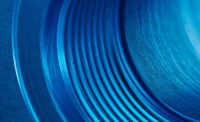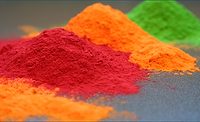More Efficient Liquid Coating of Hydraulic Cylinders Thanks to Electrostatics

KMF Kemptener Maschinenfabrik is a medium-sized mechanical engineering company based in Kempten in the Allgäu region of Germany. With around 200 employees, KMF has been producing high-quality hydraulic cylinders for the agricultural and construction machinery industry since 2002, as well as quick-change plates for wheel loaders and telescopic handlers, and customized hydraulic assemblies. The company had its origins after being founded in 1954 as a supplier and component plant for the Fendt company. The core business is the production of front and rear power lifts for commercial vehicles in the agricultural sector.
The Challenge
There is a high level of vertical integration at the Kempten site. Surface coating, which is crucial for robust corrosion protection of the cylinders, also takes place here. KMF has high demands on the coating, such as closed and smooth surfaces, uniform coating thicknesses, and a high gloss level. Until now, the workpieces were coated by hand. Bernhard Wirnharter, a member of the project team at KMF comments, "the old coating line was from the 1960`s and the process was simply no longer economical enough. To make production more efficient, we automated parts of the coating process."
In March 2020, the company invested approximately 4 million euros in the construction of a new, 800 m2 production hall, including an innovative liquid coating system with WAGNER application, dosing, and mixing technology. Powder coating was out of the question because the installed parts (seals, etc.) would not withstand the high temperatures required to cure the paint. KMF's goal was to make the best possible use of resources. In addition, the coating technology had to allow a wide variety of colors, since the components are often coated in the brand color of the respective customer. For example, in the color "Fendt Nature Green" for Fendt components.
The Solution
In the new system, the workpieces travel on the suspension with a cycle time of 7.5 minutes after the washing system through an adhesive water dryer and then into the first coating booth, where the primer is applied fully automatically. In order to reduce VOC emissions, water-based paint was originally to be used, for which the booth supply air would have to be elaborately conditioned in order to process the water-based paint reliably. This would have been an immense cost factor. KMF, therefore, opted for solvent-based paint because of its simpler handling. To save solvents, coatings with a high solids content are used. Since these coatings are more productive than those with a lower solids content, the consumption for primer and top coat is lower, which leads to a reduction in costs. The primer is prepared with the intuitive 2K Smart electronic mixing and dosing system. Exact measurement of the material flow via gear metering cells and precise dosing ensure constant and reproducible mixing ratios.

The robot-mounted AirCoat gun GA 5000 EAC with the control unit VM 5000 is used for priming. Thanks to electrostatics and homogeneous atomization, a very high application efficiency with little overspray is achieved for the large-area hydraulic components.



The soft spray jet also coats curves and hard-to-reach areas reliably. AirCoat technology thus helps to ensure that the solvent-based paint is used sparingly, which reduces both VOC emissions and material costs.



In a second booth, the top coat is applied manually. Since only 50% of the primed workpieces require a top coat, KMF had decided to automate only the priming process for the time being for economic reasons.
WAGNER's solution also brings significant advantages for manual application. The GM 5000 EAC electrostatic AirCoat gun, the counterpart to the automatic version, also enables very efficient work and high surface results. The 2K COMFORT mixing and dosing system enables fast, automatic color change. This is a major advantage for KMF, as a total of six different colors are regularly in use. In 2023, an expansion of the mixing room to ten color stations is planned so that special colors can also be processed easily and efficiently.

For a reliable paint supply, several WAGNER high-pressure piston pumps are installed, which ensure a constant material flow with low pulsation.


The Customer Experience
The new system significantly increased efficiency, as Bernhard Wirnharter explains: "We used to paint around 1,500 cylinders a day in 3-shift operation, including Saturday work. Today, we can cover the same volume from Monday to Friday in 2-shift operation."
The automatic color change for the top coat application contributes significantly to this productivity gain: While it took 30 minutes to flush, manually change and mix the paint with the old system, the setup time with the new 2K COMFORT mixing and dosing system is now only about five minutes. The faster color change process with the automatic control system not only gives KMF a high degree of flexibility and color variety, but also saves around 10 working hours per week.
Savings are also evident in the use of solvents. Thanks to the more efficient color change and shorter pipe runs that have to be flushed, 1,500kg of solvent were saved in 2021 compared with the previous year. The high application efficiency of the electrostatic guns also results in lower material consumption.
For Bernhard Wirnharter, there is another decisive advantage, "automatic coating naturally also reduces the workload of the painters. Where an employee used to have to stand in the priming booth all day with protective equipment, the robot now does the work."
Technical contact person: Alexander Vonbach Director Technical Sales, J. Wagner GmbH, alexander.vonbach@wagner-group.com
Looking for a reprint of this article?
From high-res PDFs to custom plaques, order your copy today!








